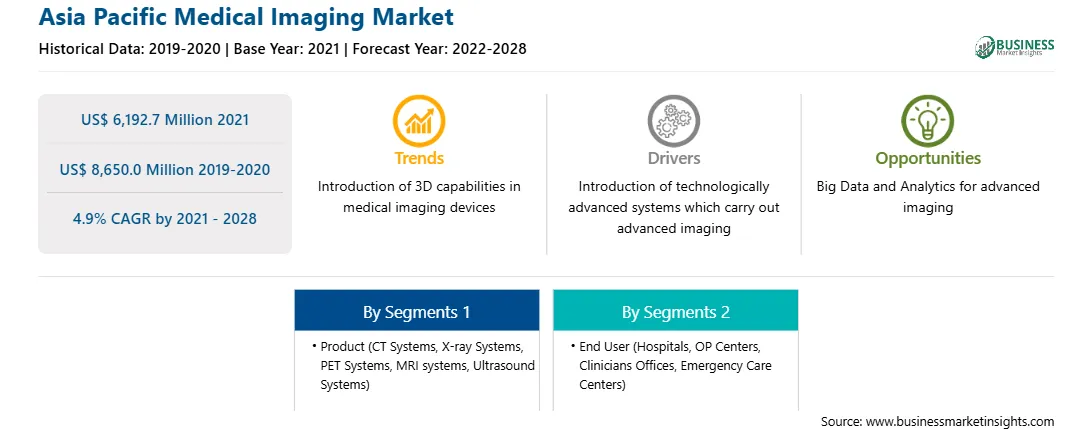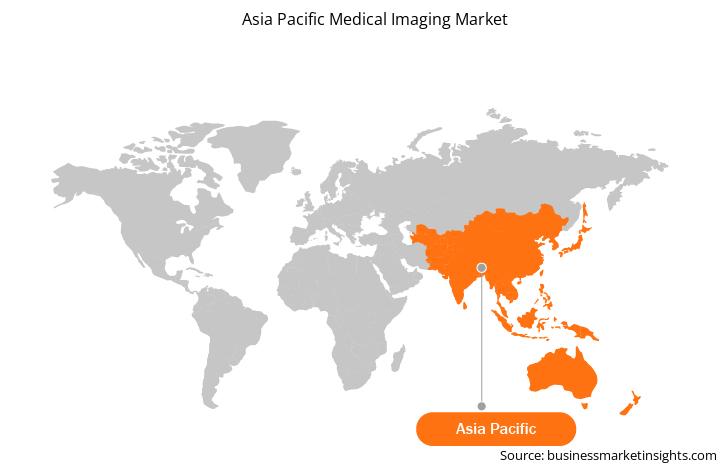Medical imaging refers to techniques and processes used to create images of various parts of the human body for diagnostic and treatment purposes within digital health. The term, medical imaging, includes various radiological imaging techniques such as: X-ray radiography, Fluoroscopy, Magnetic resonance imaging (MRI), Medical ultrasonography or ultrasound, Endoscopy, Elastography, Tactile imaging, Thermography, Medical photography and nuclear medicine functional imaging techniques e.g., positron emission tomography (PET). Medical imaging is crucial in every medical setting and at all levels of healthcare.
Thus, the increasing demand for early diagnosis are expected to create a significant demand for medical imaging in the coming years, which is further anticipated to drive the medical imaging market.
The COVID-19 pandemic has critically impacted the region, but it has also provided an opportunity for stakeholders to realign their future path based on strategic intent and focus. Moreover, various economies have been intensively making the use of medical imaging devices to diagnose, assess, monitor, and plan the treatment of patients suffering with the COVID-19. According to the World Health Organization (WHO), Imaging has been also considered to complement clinical evaluation and laboratory parameters in the management of patients already diagnosed with COVID-19 among various countries such as India, Pakistan, Japan, and others in the region. The use of medical imaging on symptomatic patients for monitoring their treatment progress required high number of these systems to perform procedures. Thus, increasing government support and reimbursement policies for medical devices are expected to support the medical imaging market. The COVID-19 pandemic has a positive impact on the market in the countries in the region.

Strategic insights for the Asia Pacific Medical Imaging provides data-driven analysis of the industry landscape, including current trends, key players, and regional nuances. These insights offer actionable recommendations, enabling readers to differentiate themselves from competitors by identifying untapped segments or developing unique value propositions. Leveraging data analytics, these insights help industry players anticipate the market shifts, whether investors, manufacturers, or other stakeholders. A future-oriented perspective is essential, helping stakeholders anticipate market shifts and position themselves for long-term success in this dynamic region. Ultimately, effective strategic insights empower readers to make informed decisions that drive profitability and achieve their business objectives within the market.

| Report Attribute | Details |
|---|---|
| Market size in 2021 | US$ 6,192.7 Million |
| Market Size by 2028 | US$ 8,650.0 Million |
| CAGR (2021 - 2028) | 4.9% |
| Historical Data | 2019-2020 |
| Forecast period | 2022-2028 |
| Segments Covered |
By Product
|
| Regions and Countries Covered | Asia-Pacific
|
| Market leaders and key company profiles |
|
The geographic scope of the Asia Pacific Medical Imaging refers to the specific areas in which a business operates and competes. Understanding local distinctions, such as diverse consumer preferences (e.g., demand for specific plug types or battery backup durations), varying economic conditions, and regulatory environments, is crucial for tailoring strategies to specific markets. Businesses can expand their reach by identifying underserved areas or adapting their offerings to meet local demands. A clear market focus allows for more effective resource allocation, targeted marketing campaigns, and better positioning against local competitors, ultimately driving growth in those targeted areas.

The Medical imaging market in Asia Pacific is expected to grow from US$ 6,192.7 million in 2021 to US$ 8,650.0 million by 2028; it is estimated to grow at a CAGR of 4.9% from 2021 to 2028. Medical imaging is an integral part of the diagnostic process. From ultrasounds to MRIs and CT scans, radiologists utilize medical imaging to properly diagnose and treat diseases. Also, doctors use medical imaging technologies to determine if a particular therapy has been effective in patient’s treatment method. Over the past couple of decades, the capabilities of medical imaging have radially increased. There have been numerous advancements in medical imaging technology owing to essential research and technological evolution. This progress is crucial in providing accurate diagnoses and bettering patient care. These advancements, along with the power of IT and digital technology, promotes greater procedural efficiency in the provision and execution of patient care.
In terms of product, the X-ray systems segment accounted for the largest share of the Asia Pacific medical imaging market in 2020. In terms of end user, the hospitals segment accounted for the largest share of the Asia Pacific medical imaging market in 2020.
A few major primary and secondary sources referred to for preparing this report on the medical imaging market in Asia Pacific are company websites, annual reports, financial reports, national government documents, and statistical database, among others. Major companies listed in the report are General Electric Company, Siemens AG, Koninklijke Philips N.V., Shimadzu Corporation, Hitachi, Ltd., Canon Inc., Hologic, Inc., Carestream Health Inc., ESAOTE SPA, and Samsung Group.
By Product
By End User
By Country
The Asia Pacific Medical Imaging Market is valued at US$ 6,192.7 Million in 2021, it is projected to reach US$ 8,650.0 Million by 2028.
As per our report Asia Pacific Medical Imaging Market, the market size is valued at US$ 6,192.7 Million in 2021, projecting it to reach US$ 8,650.0 Million by 2028. This translates to a CAGR of approximately 4.9% during the forecast period.
The Asia Pacific Medical Imaging Market report typically cover these key segments-
The historic period, base year, and forecast period can vary slightly depending on the specific market research report. However, for the Asia Pacific Medical Imaging Market report:
The Asia Pacific Medical Imaging Market is populated by several key players, each contributing to its growth and innovation. Some of the major players include:
The Asia Pacific Medical Imaging Market report is valuable for diverse stakeholders, including:
Essentially, anyone involved in or considering involvement in the Asia Pacific Medical Imaging Market value chain can benefit from the information contained in a comprehensive market report.